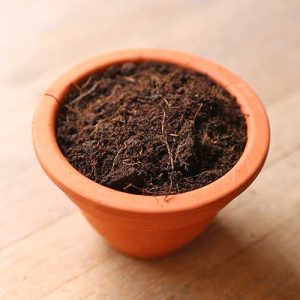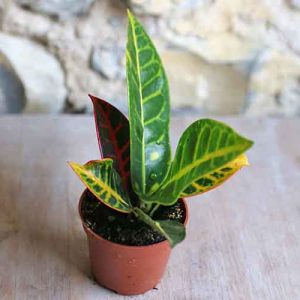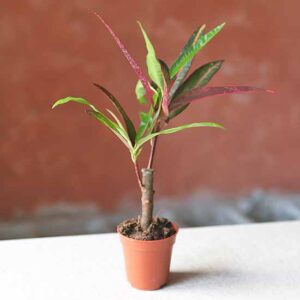HOW TO CARE FOR YOUR CODIAEUM VARIEGATUM (CROTON PLANT)
CROTON PLANTS
Codiaeum Variegatum. Common Varieties: Variegated Crotons / Petra Plants / Gold Star Plants / Oakleaf / Eleanor Roosevelt
Croton plants can vary enormously: this far-reaching genus contains 700 different species and covers a lot of bases. Ranging from tree-like structures with wispy thin leaves to squat tropical plants with distinctive veiny patterns, whatever kind of look you’re going for, a croton might do the trick. Colours range from green, variegated, yellow, red, orange, cream, pink, and black to a combination of all these so it really is safe to say that you will be able to find a croton that matches your preferred home décor.

Where Does It Come From?
Crotons are generally native to India and Malaysia. These tropical plants are usually quite full foliage-wise, with the leaves forming colourful clusters. Other varieties have since been naturalised in Oceania and flourish in the hot climates of Australia and the Pacific Islands.
Why Should I Get One?
- Crotons can be extremely resilient houseplants once they are settled in to their new homes.
- Variety, variety, variety! Crotons come in a dizzying array of shapes and colours. These tropical babes bring a bucketful of vibrancy to your interiors.
- Crotons are usually pest and disease-free which makes them easier to care for. They are only susceptible to a few common household issues like reacting poorly to dust. A weekly wipe across the leaves should avoid this.
How Big Can It Grow?
These plants can grow up to 10 feet tall in some varieties in the wild, but there are both dwarf and larger kinds that are suitable for filling big and small spaces. These plants can also be trimmed or kept in terrariums for a cute miniature look.
Where Should I Keep It?
Different varieties of croton do have varying needs when it comes to required quality of light but a quick Google of your specific variety should help you make the correct placement decisions. As a general rule of thumb, the more variegated or colourful the croton is, the more light the plant will require. The varieties with thick, dark green leaves can usually tolerate lower-light conditions. Crotons prefer to be kept warm and moist like most tropical plants and tend to suffer if the temperature drops below 10°C. For most varieties of croton, an eastern, southern or western window work well and avoiding cold air currents is a must. Crotons are toxic so be sure to keep these plants away from curious pets and small children. They can cause poisoning if ingested and nasty skin rashes if you are exposed to the saps.
TOP TIP: Crotons make a bad first impression. These plants react quite poorly to being moved, so when you plant first arrives home from the shop, it might have a little bit of a wobble. Stick with it! With the right care, these plants quickly come around.
How Often Should I Water It?
Moist but not wet is the general rule for keeping a croton happy so good drainage is essential. You should water generously but allow the soil to dry out in between watering sessions. Depending on the average heat of your home, this is usually 2-3 times per week. Crotons growing in small pots should only be watered only when the top of the soil is dry to the touch. Then, they should be watered until the water flows from the bottom of the container. Crotons benefit from a high humidity that replicates their natural conditions in the tropics, so placing it on a pebble tray or regularly misting it in addition to watering the plant will help keep it looking its best. A monthly dose of a balanced fertiliser is a welcome bonus during the growing season (spring and summer) but is not necessary during the colder months, when the plants will fall dormant.
Crotons have a bit of a reputation for fussiness, but with a few key principles in mind, you can make a resilient and hard-to-kill houseplant out of these little beauties. Once you have the correct conditions worked out for your specific variety, these tropical stunners can be a lovely and long-lived addition to your indoor garden.
-
 Sold OutSelect options This product has multiple variants. The options may be chosen on the product page quick viewQuick View
Sold OutSelect options This product has multiple variants. The options may be chosen on the product page quick viewQuick ViewHouse Plant Soil Suitable for Terrariums
View All, Terrarium Moss, Decor + Tools, Soil, Grit + Gravel £2.00 – £2.50 -
Quick View
-
Quick View
Small Croton Plant (Codiaeum) with Variegated Leaves
Baby House Plants, Mini Terrarium Plants, View All £6.30


